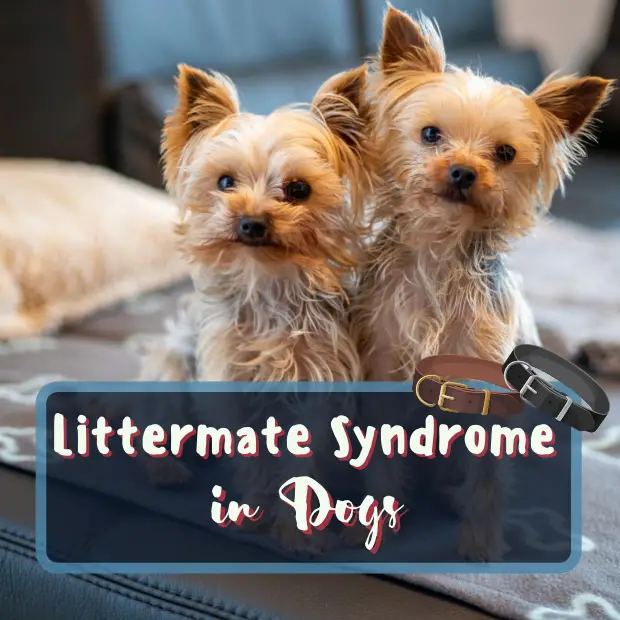Littermate Syndrome is an anecdotal umbrella term that refers to a range of behavioral problems which can develop when two or more puppies are raised together in the same household after 8-12 weeks of age, when they would normally be separated to go to new homes.
Table of Contents
ToggleContents of this article:
- What is littermate syndrome?
- How will dogs with littermate syndrome behave? What does littermate syndrome look like?
- Intensity of littermate syndrome.
- Is littermate syndrome dangerous?
- How can I tell if my dogs have littermate syndrome?
- What behaviors are sometimes confused with littermate syndrome?
- What causes littermate syndrome in dogs?
- Should I consult a canine professional about littermate syndrome?
- Is littermate syndrome curable?
- Can littermate syndrome be prevented?
- What NOT to do when your dogs have littermate syndrome.
- What are the consequences of owners’ inability to resolve littermate syndrome?
- Is there anything else I should know about littermate syndrome?
- What to do next…
What is littermate syndrome?
It’s a catchall term to describe the issues for two young dogs raised together that develop behavioral problems because of an unhealthy codependency. Most commonly, it develops when puppies from the same litter are placed together in a new home, although it can happen in unrelated young dogs with up to a year’s age gap.
Behavior issues are most commonly seen in puppies adopted from the same litter, but can also occur when any two young dogs are raised together without sufficient human intervention.
Because of this, many rescues and shelters will not allow the adoption of siblings or introducing a puppy into a household with another dog of less than a year old.
When two young dogs are raised together, they often lack sufficient experiences with humans and other animals outside of each other. This can lead to an extreme interaction style in which one dog may assume control, while the other is more passive.
This type of codependency can lead to aggression, anxiety, and other behavorial problems.
How will dogs with littermate syndrome behave? What does littermate syndrome look like?
Symptoms of Littermate Syndrome include:
- extreme possessiveness over food, toys, or other items
- aggression toward siblings and humans
- anxiety/fearfulness in response to new stimuli (sounds, people)
- anxiety when apart from each other (e.g. whining, constantly looking for the other)
- social problems outside of the home
- lack of bond with their humans
- impossible to train, as they cannot focus without their sibling
- relying on each other to the point of complete dysfunction
- and general anxiety
Intensity of littermate syndrome.
Often on social media, you will hear people say that littermate syndrome doesn’t exist. That they raised two puppies together with no problems and their dogs are inseparable. That’s literally the problem!
Littermate syndrome is not a myth. It’s real and can be very problematic for the dogs that are afflicted with it. Imagine trying to live your life not being able to cope without your sibling being within sight… that’s what it’s like for these dogs on a day-to-day basis.
At the severest end of the spectrum of littermate syndrome, one dog will physically bully and attack the other to the point they will fight to the death.
Is littermate syndrome dangerous?
Many people have horror stories to share about experiences when littermate syndrome leads to extreme aggression, with some leading a “crate and rotate” lifestyle to stop the dogs from seriously injuring each other… or worse.
In situations like these, one lapse of control and management can lead to catastrophic consequences.
How can I tell if my dogs have littermate syndrome?
If your dogs’ behavior meets any of the descriptions above, it’s time to seek help!
What behaviors are sometimes confused with littermate syndrome?
If your dogs are anxious about being left home alone but still in sight of their sibling, it could be separation anxiety, rather than littermate syndrome that your dogs are suffering with.
If your dogs become agitated and behave in a manner that we might describe as aggressive only when there is a physical barrier between them such as a stair gate or crate, this could be barrier frustration.
What causes littermate syndrome in dogs?
This is a common question, and one that doesn’t have a simple answer. As with many canine behavior problems, very often it is a combination of factors that cause littermate syndrome.
Spending too much time together without human intervention is a common theme amongst dogs that suffer from littermate syndrome.
Dogs who do not have outlets for exhibiting natural species- and breed-specific behaviors (i.e. doing things that dogs love to do) are also at higher risk of developing behavioral problems, which can include littermate syndrome.
Should I consult a canine professional about littermate syndrome?
Littermate syndrome in dogs should always receive professional attention, as each case is unique.
An experienced, positive-reinforcement behaviorist should be contacted for help if the dogs are exhibiting any issues. They can give recommendations on how to interact with the dogs and can help determine a plan of action that will reduce the risk of developing problems.
Littermate syndrome can become serious enough that one dog may need rehoming.
Is littermate syndrome curable?
Not always. Many dogs with littermate syndrome can be successfully treated through training and behavior modification (with or without medication to help with the anxiety), but many others cannot.
While it may be adorable to see one puppy following another around the house, your dogs should always be able to spend time apart from each other without incident.
Can littermate syndrome be prevented?
As with many cases of behavioral issues, good control and management can reduce likelihood of problems. Owners should be aware of this syndrome and be proactive in preventing it from becoming a problem.
In some cases, littermates are raised with the minimum of intervention, barely spend any time apart and grow up to be as confident and independent as any dog raised alone. It’s a bit like walking across a busy road blindfold though – you might be lucky and reach the other side unscathed, but the odds are not in your favour!
To actively avoid littermate syndrome, I would always advise the dogs spend as much time apart as possible, ideally spending more one-to-one time with their human than they spend with their sibling.
Separate bowls, separate beds, separate walks, separate training, separate crates, separate everything!
Proper socialization to new people, animals, sounds, and situations should begin as early as possible. Owners should expose puppies individually to new situations daily. This allows for positive experiences with the new stimuli without each other present. The easiest way to achieve this is to get them used to going out for walks individually.
Playing stimulating games, doing gentle training for obedience and tricks, and other activities that allow for positive interaction with the owner and other humans.
Teach each of your dogs to be independent and confident without needing the other’s presence. Puppies’ owners should provide activities that decrease codependency, such as interactive toys. Enrichment puzzles and toys that require problem-solving to get food treats will help build a dog’s confidence, rewarding them for trying new things, and encouraging their curiosity.
When spending time together with their owner and other pets/humans, it may be beneficial for one littermate to have a job, such as foraging or playing with interactive toys, while the other rests. This gives the dogs an outlet for their energy and prevents them from becoming overly focussed or fixated on each other.
Get them accustomed to being left home alone individually for short periods, too. This can be invaluable if either of your dogs ever needs to stay at the vets overnight or if you need to get them looked after separately whilst you go on holiday.
What NOT to do when your dogs have littermate syndrome.
Don’t let them “sort it out themselves”. The dogs should be separated immediately if any fighting starts. If they are allowed to keep interacting with each other, new issues may arise. Fighting can escalate by one dog bullying the other and seeking out opportunities to attack, and it can lead to injuries that will become harder to treat.
Siblings should never be left alone together – especially if they started having issues at a young age. They should also not be isolated without human contact.
What are the consequences of owners’ inability to resolve littermate syndrome?
I’m aware of several pups who have had to be rehomed due to littermate syndrome emerging.
Not that pups are destined to get it. The chance of acquiring it can be lowered with adequate training. And, sometimes, even with no training, it will never happen.
It’s important to remember that littermate syndrome has two faces: over-reliance on one another or hatred for one other. There is a lot of space between those two poles for healthy development.
Is there anything else I should know about littermate syndrome?
In my experience as a trainer, sibling dogs that are not the same sex generally have better outcomes.
There is nothing wrong with having two puppies, but socialising each of them both separately and together so that they can cope in all scenarios is actually three times the work of having one puppy.
I’ve been there and done it. If I had my time over and the circumstances were the same, I’m not sure I’d do it again. I feel like I missed out on many aspects of each of my dog’s puppyhoods and I couldn’t give each dog as much attention as I’d have liked. Next time, I will raise one puppy on their own and give them my undivided attention for the first two years until they are a mature adult dog.
What to do next…
If you feel like your dogs might be showing signs of littermate syndrome, seek out the help of a professional canine behaviorist who can guide you through the steps needed to resolve the issue.
Check out this article for more info about tactics to help avoid littermate syndrome.







